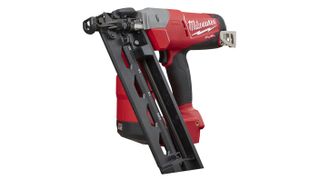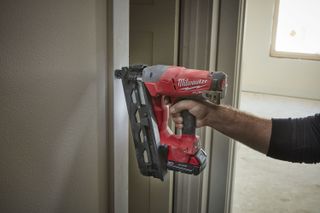Milwaukee M18 Fuel Cordless 16-Gauge Angled Finish Nailer review: the most versatile cordless nailer
This do-it-all Milwaukee M18 nailer handles a range of tasks around the house including fitting trim and molding, and it’s as easy to use as your other battery-powered tools


Most power tool manufacturers offer a 16-gauge nail gun, but Milwaukee offers both an angled and straight version of it. We like the angled because it provides better access in tight corners, though they both work well. The Milwaukee isn’t the least expensive option, but it’s well built, powerful, and reliable, so it should last for years.
-
+
Ease of use
-
+
Fast, consistent nailing even in hardwood and dense MDF
-
+
Sold as a bare tool, which lowers the cost if you already have 18-volt Milwaukee power tools, and as a straight nailer if you prefer that configuration
-
+
The handiest nail gauge to have, if you can only have one
-
-
Heavier than other 16-gauge nailers
-
-
The angled design won’t stand straight up, so you have to rest it down
-
-
Thicker 16-gauge nails can split thinner wood pieces
Why you can trust Real Homes
In the vast world of nailers, the 16-gauge might be the most useful one to have. Sure, the 18-gauge brad nailer is ubiquitous, but the slightly beefier nails the 16-gauge fires provide better holding power for a wider range of materials and tasks.
Generally, 16-gauge nailers, depending on the brand, use fasteners from 3/4-inch to about 2 1/2-inches long. The nails the Milwaukee M18 Fuel 18-Volt Lithium-Ion Brushless Cordless 16-Gauge Angled Finish Nailer uses start at 1 1/4-inch. The nail's body and head are slightly wider than an 18-gauge, yet smaller than a 15-gauge. That extra heft and nail length – most 18-gauge tools max out at 2-inch-long nails –makes it easier to hold larger, heavier pieces of wood or MDF, like window and door trim, fireplace mantles, baseboard and crown molding in place. Yet the hole a 16-gauge nail leaves behind is only slightly larger than an 18-gauge tool, and still just as easy to fill before painting or staining.
About the only thing the 16-gauge nailer won't excel at is supporting heavy pre-hung doors, which is where you’d lean on a 15-gauge tool. Fastening thin, small pieces of wood takes extra precaution because a fatter 16-gauge nail can split the material easily.
Now you know what kind of jobs the Milwaukee M18 Fuel Cordless 16-Gauge Angled Finish Nailer is best suited to, find out how it performed in our testing. Then for more recommendations, see our best power tools.

Milwaukee M18 Fuel Brushless Cordless 16-Gauge Angled Finish Nailer specifications:
- Gauge: 18
- Nail length: 1.25–2.5 inches long
- Run time: drives about 700 nails per charge
- Power: cordless (18-volt 2.0Ah compact battery)
- Weight: 6.3lbs with battery
Who does the Milwaukee M18 Fuel Cordless 16-Gauge Angled Finish Nailer suit?
Before deciding if this 16-gauge nailer is for you, it’s worth mentioning how reliable and consistent the category of battery-powered tools has become. More and more contractors are moving over to nailers that use a battery because these tools stand up to the rigors of a job site, they require very little maintenance, and they deliver performance that is right up there with the benchmark – compressor-driven tools – for all but the most demanding tasks.
These modern nailers use a lithium-ion battery pack, just like any other tool in your garage. But unlike traditional nailer styles, these don’t require much maintenance – like adding oil. At most you'll be tasked with ejecting the occasional jammed nail, which is something that happens on all nailers. There is no more fretting about expired gas fuel cells, setting up a noisy compressor or dragging a hose around, or worrying about an outlet.
If the battery is charged, you’re ready to complete a project. Battery-powered nailers have the same rapid-fire option, or bump fire as the pros call it, that shoots nails into the work surface in rapid succession without any lag time. Maybe you've seen roofers use a nail gun to attach shingles rapid fire – that's the gun on bump mode. With a 16-gauge tool that can be helpful if you’re nailing in a long piece of molding, like a chair rail.
Choosing a 16-gauge nail gun
While the 18-gauge nailer is the most popular style for homeowners, pros will say, if you can only have one, make it the 16-gauge. The widths and length of the fastener make it ideal for a wider range of tasks than the 18-gauge can take on. A 16-gauge gun can do nearly all the small to medium size molding and trim you'd reach for an 18-gauge tool to complete, but it will also take on chunkier and heavier wood or MDF moldings – the kind you might need for board and batten or DIY wainscoting.
On the outside of a home, the longer nails plow through 3/4- or 1-inch-thick PVC moldings too, which would be a lot to ask of an 18-gauge tool. Pros also use it to install wood flooring close to the wall where a hardwood flooring stapler can’t reach. you can also use it around the garage for woodworking or building projects.
Once you’ve decided on a 16-gauge nailer you’ll have to pick between straight or angled styles. Like Milwaukee, many brands offer 16-gauge (as well as 15-gauge) nailers in both styles. The nails they use are not interchangeable – a sleeve of straight 16-gauge nails will not fit in the angled magazine of a 16-gauge gun. Sometimes the angled magazine enables that style of nailer to hold more fasteners, though with Milwaukee both hold 110. Angled nailers have an advantage in that it’s easier to put the nose of the tool into tight corners, like where two pieces of baseboard meet.
What is the Milwaukee M18 Fuel 16-Gauge Cordless Angled Finish Nailer like to use?
When a brand releases cordless nailers in the 16 and 15-gauge categories, it signifies a belief that the technology is ready to keep pace with traditional, compressor or gas-fuel cell fired tools. It’s one thing to drive thinner, 18-gauge nails, but the tool has to be dialed in to push chunky 16-gauge nails. And the Milwaukee does just that with every pull of the trigger.
Unlike first-generation battery-powered nailers, this modern breed doesn’t rely on a flywheel so there is no second or two lag while the tool develops the energy to push the piston that drives the nail. When you pull the Milwaukee’s trigger, it instantly fires a nail. The brand claims it will sink three nails per second, and while we didn't time it, that feels accurate. There is only some slight reverberation in the arm, but not enough to be uncomfortable unless you're working overhead for long hours.
The depth of drive adjustment makes it easy to go from pine to hardwoods, to dense engineered material like MDF and even very thick PVC. In each case, the nail sank to the right depth and the only time it strayed was if the nose wasn’t perfectly flush with the work. It only takes a short while to get used to the placement of the nosepiece in relationship to where the nail fires. In no time we were sinking nails exactly where we expected.

Additional features of the Milwaukee M18 Fuel Cordless 16-Gauge Angled Finish Nailer
There are a few features that make the Milwaukee easier for DIYers to use. The rear-mounted selector switch makes it clear to see what firing mode you’re in – single-shot or bump fire. And if the tool sits for a few minutes, it powers down for safety.
A dry-fire lockout feature prevents the piston from marring the wood when there are no nails in the magazine – a mistake that happens to everyone in the rhythm of sinking nails. When the magazine gets down to about five nails, it will not fire until you load in more.
Like all modern nailers, if you experience a jamb, a quick unlatching behind the noise piece lets you clear the errant faster by hand or with a pair of needle nose pliers. Though with 16-gauge nails you’d rarely be sinking them that quickly. The belt hook attaches to three different points on the nailer, suiting both left and right-hand dominant users.
Though one thing we didn’t love, and is something common on angled tools: the nailer does not want to sit upright because of the magazine holding the fasteners. It sounds like a small detail, but if you have to set the tool down on its side multiple times during a project, that gets old fast.
Is the Milwaukee M18 Fuel Brushless Cordless 16-Gauge Angled Finish Nailer worth the money?
Yes, if you’re a DIYer with the budget to buy one quality nailer to add to the tool kit and you enjoy installing trim. If you have a variety of interior and exterior molding jobs to work on, or plan to install your own hardwood flooring, this nailer is the right tool to use. If you’re already invested in the Milwaukee M18 tool platform, you can purchase the 16-gauge nailer without the battery and charger, saving more than $100.
While it’s not the least expensive or the lightest tool on the market, the Milwaukee is well built and you can expect nearly zero maintenance and to sink about 90,000 nails before it needs service.
About this review and our reviewer
Sal Vaglica has been covering all aspects of home improvement for over 10 years, for publications like The Wall Street Journal, This Old House, and Men's Journal.
He tested the Milwaukee 16-gauge nailer by firing nails into a variety of materials, like 3/4-inch-thick pine, 1/2-inch thick oak, and 1/2-inch thick MDF, and 3/4-inch PVC to test for accuracy, reliability, and ease of use.
Join our newsletter
Get small space home decor ideas, celeb inspiration, DIY tips and more, straight to your inbox!
Sal Vaglica has been covering all aspects of home improvement for over 10 years, for publications like The Wall Street Journal, This Old House, and Men's Journal.